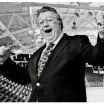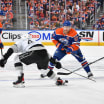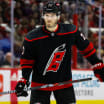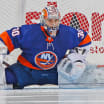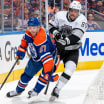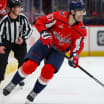The process began three years ago when the late Ed Snider, owner of the Philadelphia Flyers, spoke at a Competition Committee meeting in New York. The NHL and the NHL Players' Association had been discussing ways to improve the game, and Snider focused on a big issue: goalie gear.
NHL, NHLPA add new chest, arm pad rules for goalies
Guidelines aim to eliminate equipment advantages, increase scoring
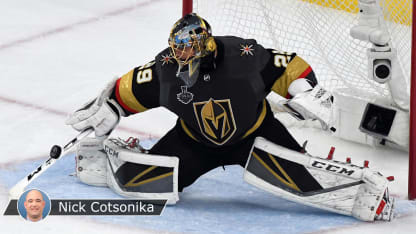
© Getty Images
"He made an impassioned plea to the group to say, 'Guys, we can still do more in this area. We think they're still too big,'" said Kay Whitmore, NHL vice president of hockey operations. "I think we owed it to him to follow through and get it done once and get it done right."
First, leg pads and pants were streamlined. Now, as NHL teams open training camps this week, chest and arm pads have been as well to comply with a detailed new rule developed by the NHL and the NHLPA.
The goal isn't more goals, exactly. It's for goaltenders to make saves because of ability, not equipment. They should wear equipment that fits properly -- enough to protect them, but not extra to stop the puck. A 200-pound goaltender should not look like a 250-pound goaltender.
"The assumption is that it's primarily to increase goal-scoring, and it is," said Mathieu Schneider, special assistant to NHLPA executive director Don Fehr. "We'd be lying if we didn't say that was a big part of it. But I think the fairness is certainly a close No. 2 on that list. We're trying to come up with rules and guidelines that don't give players a distinct advantage because of their equipment."
Whitmore said the effect on scoring could not be predicted, but the gap between the best and average goaltenders should increase.
"It should be about skill and athleticism and all those exciting things that people pay to watch, as long as [the goaltenders] are protected and it's fair from goalie to goalie," he said. "That's the main thing."
* * * * *
Look at a picture of a goaltender from the 1980s and one from the 2010s side by side, and the difference is stark. But look at pictures year by year, and the growth is gradual, a spectrum. People have talked about the size of goalie gear for years, but at what point do you take action and what specific action do you take?
The NHLPA once polled its goaltenders: Which would you prefer? Bigger nets or smaller equipment? It was unanimous.
"I thought we would have had at least a couple of guys that would have said, 'Oh, you know, maybe we should make the nets bigger,'" Schneider said. "But that wasn't the case at all. That would have introduced a whole other set of problems if we looked at making the nets bigger."
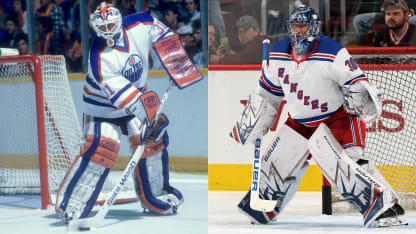
© Getty Images
But making the equipment smaller did introduce a set of problems. It is easy to say and hard to do when you have well over 100 goaltenders of all shapes and sizes in the NHL and the minor leagues and at least six manufacturers spending time and money to design their own models. How do you define it? How do you implement it safely and consistently?
The leg pads and pants were relatively straightforward. Whitmore said everyone used to wear the largest pants size he could, but when the pants rule was implemented in January, the NHL went from a two-size league -- large and extra large -- to having some goaltenders in small and medium, many in large, and very few in extra large.
"We have a bigger size range now that fits everybody," Whitmore said.
The chest and arm pads were more complicated because of their inherent intricacies, the area of the body and the nature of the game. Imagine spending years in equipment protecting sensitive areas, getting comfortable with it, trusting it, then having someone change it and facing slap shots off composite sticks. The NHL isn't going back to wood.
"This piece of equipment is more personal than probably anything that you could compare it to on any player on the ice," Schneider said.
The NHL and the NHLPA went back and forth with goaltenders and manufacturers, first outlining the general principles, then drilling down the details.
"The whole thing was, try to make equipment that mimics the shape of the body that it's protecting … [while] never reducing protection," Whitmore said. "We've tried to remove equipment from areas there's no body part behind."
Rule 11.3 -- Chest and Arm Pads -- is 608 words long. It states, "The chest and arm protector worn by each goalkeeper must be anatomically proportional and size-specific based on the individual physical characteristics of that goalkeeper," then gives precise measurements for elbow, arm, clavicle and shoulder protection.
Elbow floaters have been reduced from 7 inches to 6 across the front. Bicep and forearm pads must taper -- 5.5 inches to 4.5, then 4.5 to 4. Clavicle floaters cannot extend more than 2 inches above the shoulder at the lateral edge, 1.5 inches at midpoint and 0.5 inches at the medial edge. Shoulder caps cannot project laterally beyond shoulders more than 1.5 inches.
In short, pads must be tighter to the body and also slope with it -- from neck to shoulder, from upper arm to forearm -- and can't be worn so they pop up when a goaltender drops into the butterfly position. There are more parameters to make it harder to circumvent the rule.
"The biggest complaints I always got were how square goalies looked, because nobody's really built like that," Whitmore said.
Each model is sent to a third party, put on a mannequin and measured by a 3D scanner in Philadelphia for approval, technology that didn't exist years ago and helps make this work now.
Then each piece of equipment worn by a goaltender is sent to Whitmore in Toronto for inspection before it is shipped to a team. If Whitmore sees something off, he doesn't have to rely on his eyes. He can send it to the 3D scanner to check it, as he did once recently.
"The scanner proved that there was one part that had been assembled improperly," Whitmore said. "Not intentionally. Just was an oversight at a factory in production. I think it's the best way to keep the manufacturers honest."
* * * * *
Will shooters notice?
"I hope," Pittsburgh Penguins center Sidney Crosby said with a laugh. "I hope it's that obvious. Sometimes it's really subtle. You can't necessarily tell."
Non-goaltenders might not be able to. Schneider said when he looks at an old unit next to a new one side by side, he doesn't see that big of a difference, and he played 1,289 games as an NHL defenseman and has been involved in this process from the start.
But goaltenders see the difference right way, and they feel it on the ice. Opinions are personal, based on circumstances and taste. Careers are at stake. No one has worn the new equipment in a game yet, let along gotten used to it.
"Meh," Vegas Golden Knights goaltender Marc-Andre Fleury said. "I don't know. I think it's not that bad. It's not awful. I feel like I get a few more stingers on the arms and stuff, but it's still a work in progress a bit to make it better."
Told he should have an advantage as an athletic goaltender, Fleury pointed out he was 6-foot-2, 180 pounds.
"I'm not a big guy, either, right?" he said. "So I look even smaller. So I've got to try to stay fast, try to stay on top of it."
But that's just it. It is a work in progress, and the point is for goaltenders to be smaller, to stay fast.
Whitmore has been speaking to goaltenders constantly, using FaceTime for visuals and refining individual pieces of equipment. He will continue to do so throughout training camp and the preseason, and into the regular season.
"To each their own, right?" Whitmore said. "There's going to be higher-maintenance guys, lower-maintenance guys. It's expected. So you just kind of deal with it case by case. Some guys play differently. They may get hit in a place they feel something is a little lacking, and we'll work with them to get that fixed."
Schneider said the NHL and the NHLPA want to make sure goaltenders feel safe early, then make sure the size of equipment is capped going forward. He thinks manufacturers will keep innovating and improving the equipment, only now within the new constraints.
"I think the most important thing is, no one's feeling comfortable right now," Schneider said. "We know that there's still work to do. We didn't just write a rule, or agree on a rule, and expect that we're going to show up on Sept. 15 or whenever camps open and it's done and we're walking away.
"It's been a long process, and we're close to the finish line, but we still have work to do on it. I think this is going to continue throughout at least the first half of the season, where we're making sure that all guys' concerns are addressed, and if they have areas that they think they're not protected, then we've got to make sure that they feel protected."


